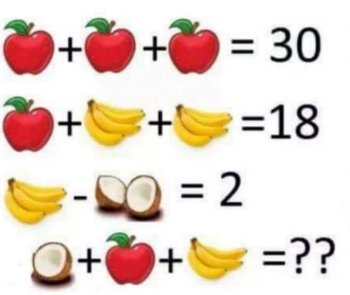Ask Professor Puzzler
Do you have a question you would like to ask Professor Puzzler? Click here to ask your question!
Laina asks for an explanation of the puzzle shown below.
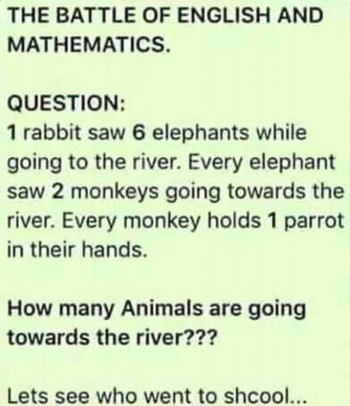
The text reads: "THE BATTLE OF ENGLISH AND MATHEMATICS.
1 rabbit saw 6 elephants while going to the river.
Every elephant saw 2 monkeys going towards the river.
Every monkey holds 1 parrot in their hands.
How many animals are going towards the river???
Lets see who went to shcool..."
First, I doubt I'll be able to solve this, since I never went to shcool...
However, my answer is, simply, there is no solution, because there is not enough information given.
This is like a poor man's version of the "St. Ives" riddle. In case you don't know that riddle, it goes like this: "As I was going to St. Ives, I met a man with seven wives. Every wife had seven sacks, every sack had seven cats, every cat had seven kitts. Kitts, cats, sacks, wives, how many were going to St. Ives?"
With the St. Ives riddle, the narrator meets a man with seven wives. The word "meets" strongly implies* that the man with seven wives was going in the opposite direction.
Notice, though, that in our question here, it does not say that the rabbit "met" the elephants, only that he saw them, which could certainly mean that he overtook them as they were also on their way to the river. We simply don't know what the elephants are doing, and therefore there is not enough information to definitively answer the question.
I could end there, because the answer is indeterminate. However, I think it's worth exploring the question further.
The next question that arises is, how many monkeys are there? The two most common answers to this are two and twelve.
The first answer comes from assuming that each elephant saw the same two monkeys, and the second answer comes from assuming that each elephant saw two monkeys that none of the others saw. The most compelling argument for "two" as the answer is that the problem uses the word "every" instead of "each." The word "every" is a group word, implying the group as a whole did something. Thus, the group, as a whole, saw two monkeys. It's an interesting argument, but not all that convincing; grammarly states that each and every can be used interchangeable in some circumstances, and Cambridge Dictionary gives us such an example:
Each person has a bicycle.
Every person has a bicycle.
Both of these statements mean that there is a bicycle for each person. If we aren't going to assume that every person has the SAME bicycle (meaning, of course, that there's only one bicycle), then we can't assume that every elephant saw the same two monkeys.
Nor can we assume that every elephant saw two distinct monkeys that none of the others saw.
Therefore, there must be somewhere between 2 and 12 monkeys, inclusive, but the exact quantity of monkeys is unknown. Giving us, once again, an indeterminate answer.
There was another argument I saw for two monkeys - some people were saying, "since the problem doesn't state explicitly, implicit rules apply, making it two." Implicit rules? What is that? Is it just a fancy way of saying, "Since they didn't specify, I get to pick whichever makes the most sense to me, and call it the 'default' meaning."?
Regarding the parrots, it's interesting to me that the people who present the "each vs. every" argument are inconsistent; If "every elephant saw two monkeys" means that the group as a whole saw two monkeys, then "every monkey holds one parrot" means that the group as a whole is holding a parrot, and there is one parrot, instead of two parrots. It seems to me that you can't have it both ways.
Finally, there really is no battle between English and Mathematics. I've been hired to write competition math problems in at least three different states, and I can tell you that English and Mathematics work side-by-side to make a good problem. Ambiguity in the use of English makes the problem unsolvable. If this problem showed up in any math competition anywhere, the appeals committee for the competition would be inundated with appeals written by students arguing for different answers. The appeals committee would have to accept multiple answers or throw the problem out entirely (I saw this happen just a couple weeks ago at a state math competition; because of one missing word in a problem, the problem was thrown out, and no one received any points for it).
I asked my problem proofreader what he would do if I sent this problem to him to proofread. He assured me that he would throw it out. He also said:
"I think this is a wonderful problem for a class discussion, but not for any type of grade or for a competition. There is far too much ambiguity for it to be a problem with a well defined answer."
* Even the St. Ives problem is ambiguous; there isn't actually a solid reason to conclude that the man with seven wives is going in the opposite direction; the narrator could have simply caught up with the man (all things considered, he's probably going fairly slowly!) and struck up a conversation with him. That is an appropriate usage of the word "meet," and the St. Ives problem is therefore ambigious.
Steve from Cincinnati writes: "I believe this puzzle answer is 1089.
11 X 11 = 4
22 X 22 = 16
33 X 33 = ???
"The first two equations are wrong, but they trick us into looking for a pattern rather than apply the mathematical rules...many people assume an addition function exists between each of the two pairs of integers. Not so. Therefore, thirty three multiplied by thirty three is 1089."
Hi Steve! Of course, you are 100% correct. 33 x 33 = 1089, no matter how many incorrect equations you put before it. Now that I've said that, if I stop there, I've got a really short blog post, and no one wants that - so let's fix their notation in order to turn it into a more interesting puzzle. We'll treat it as a single variable function:
Find x if:
F(11) = 4
F(22) = 16
F(33) = x
It still isn't a very good puzzle, though, because there's not enough information to come up with a single solution. In that respect, it's very similar to the "Squares Problem" I wrote up last year. Here are just three possible answers to the puzzle.
Solution #1
We add the digits of the number in the function's domain, and then square it. (1 + 1)2 = 4; (2 + 2)2 = 16; (3 + 3)2 = 36.
Solution #2
We square the number, and then add the digits: 112 = 121 and 1 + 2 + 1 = 4; 222 = 484 and 4 + 8 + 4 = 16; 332 = 1089 and 1 + 0 + 8 + 9 = 18.
Solution #3
We subtract 8 from the number, and then add the quotient the number and eleven: 11 - 8 + 11/11 = 4; 22 - 8 + 22/11 = 16; 33 - 8 + 33/11 = 28.
I'm sure there are other solutions; those are just the ones that popped into my head on a quick glance. Can you come up with others? Send them my way and I'll add them to this post.
I'm Glad I've Got a Proofreader
In addition to occasionally writing math problems for this website, I've also written math problems for several states' math competitions. When I sit down to write problems, it's usually because I have to crank out a set of 100 math problems for a competition somewhere. When I'm finished writing them, I send them off to my proofreader. When he's proofreading, what do you suppose he's most likely to find?
- spelling mistakes
- grammar mistakes
- arithmetic errors
- algebraic errors
- ambiguity errors
He does occasionally find spelling/grammar mistakes, but those are fairly infrequent. And yes, I do occasionally have arithmetic/algebraic errors! (When I'm writing a problem, sometimes I have to try two of three different things to make the problem work out correctly, and then I forget which things I've changed, and use numbers from the first version of the problem, and then my proofreader says, "Where in the world does this number come from?")
But the most common issue he finds is an ambiguity issue. Ambiguity simply means that students could reasonably interpret the problem in more than one way. If the student could interpret the problem in multiple ways, then it's a bad problem!
Here's a simple example:
In a right triangle, the sides are 5, x, and x + 1. Find the length of the hypotenuse.
Why is this ambiguous? Because I've implied that there's one answer ("find the length" instead of "find all possible lengths") but there are two possible answers, because the hypotenuse could be 5 (if x and x + 1 are less than 5) or it could be x + 1 (if x + 1 is greater than 5).
Here's another example:
Find the next term in this sequence: 5, 10, 15, ...
The obvious answer is 20, but that's not the only possibility; someone who is familiar with Fibonacci sequences could argue that this is the beginning of a Fib, and therefore the next term is 10 + 15 = 25.
These are just simple examples. The more complicated a problem is, the more likely it is to introduce something ambiguous without meaning to. So I'm glad I've got a problem proofreader.
The Internet Has No Proofreader
Now I put on my other hat - the "Professor Puzzler" hat. On any given day, this blog is a pretty quiet corner of the internet. This blog usually gets just a few hundred visitors per day. (Except on days we publish a new post, then the visitor rate climbs a bit).
But every once in awhile, something goes crazy. Back in February, for instance, there was one day where the traffic to the Professor Puzzler blog was 100 times it's normal rate. We had over 25 thousand page views on just one page of the blog.
Whenever this happens, it's invariably because someone posted an ambiguous (bad) math problem on the internet, and someone linked to our explanation of why it can't be solved.
And I realized something, after the most recent one: the majority of math problems posted on social media are ambiguous. The internet has no proofreader.
If you're interested to see some of the ambiguous/bad problems we've talked about in this blog, here are links to some of them. Just click on the image to jump to the corresponding blog post.
The most recent one was "The Flower Problem" or (as one site called it) "Pollen Pandemonium." This problem is straight-up ambiguous (and no, it was not part of a kindergarten exam in China; give the Chinese some credit, will you?). The most appropriate interpretation is to say that each distinct flower image represents a different variable. If that's the case, you have a system of three equations in four unknowns, which is unsolvable. If you operate from the assumption that the problem must have a solution, you reject the most appropriate interpretation, and then there is no way to solve it without making an assumption about what the writer intended. Each assumption will lead you to an answer, but depending on the assumption you make, you'll get a different answer. So the internet is full of people arguing for their interpretation, when the reality is, every solution is based on an unwarranted assumption.
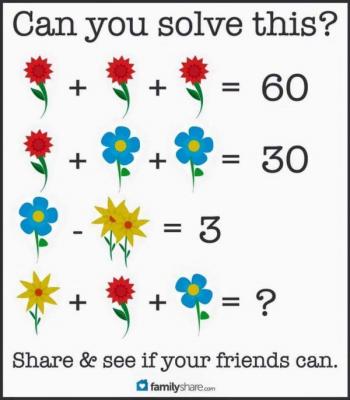
The square problem is also ambiguous in the same way that my sequence problem above is ambiguous; there are multiple ways of interpreting the intent of the problem writer, and there isn't one right answer; there are many possible answers. But the problem is great for click-bait sites, because people will spend all day arguing their answer in the comments.
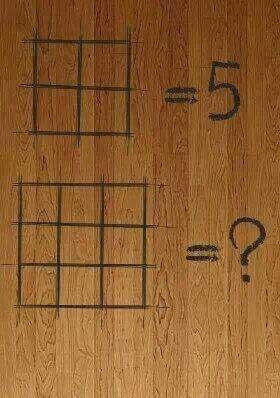
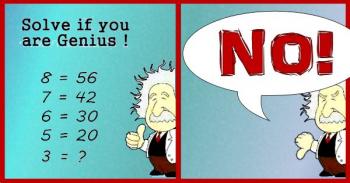
And there you have it: a history of bad math problems on the Ask Professor Puzzler blog. Click-bait sites love problems like this, because they generate arguments, and arguments turn into page views, comments, likes, and notoriety.
Math teachers, on the other hand, hate them...except as teaching tools about ambiguity!
Update June 20, 2016: One wise commenter responded to this blog post by saying "So people would rather argue, pretending unsolvable problems are solvable, than accept the simple fact that the problem was badly phrased to begin with. Seems this could have applications to Internet interactions far beyond the math realm!"
Can't argue with that!
DailyMail.co.uk, and the various click-bait sites that copy their content, seem to be a bit confused on the difference between "hard" and "unsolvable." They recently discovered the "flower problem" (which everyone else was talking about four months ago), then they found our explanation of the problem, and posted a fine click-bait article headlined something along the lines of "Problem is so hard even a math teacher can't solve it."

There is a huge difference between something being "hard" and something being "unsolvable."
Let me give you an example:
John can mow lawns at a rate of 1 lawn every three hours. Jane can mow lawns at a rate of 2 lawns every five hours. If John and Jane work together, how many brick walls can they build in ten hours?
This is not a hard problem. It's actually very, very easy. It's very easy to recognize that the answer is "not enough information given." Information about rates mowing lawns doesn't tell us a blessed thing about their wall-building rates.
"Hard" implies that someone will actually spend a lot of time wrestling with the problem. But, in fact, you didn't spend any time at all on that, right? You knew immediately and instinctively that there wasn't enough information to solve it. That wasn't hard.
Here's another problem:
If x + y = 30, find the value of 2x - 3y.
Now this one is a little harder, because it might not be immediately apparent that there isn't enough information to solve the problem. Any first or second year Algebra student, however, shouldn't spend much time on that before they say, "Hey, wait a minute! There are two variables there, and only one linear equation, so I can't find x and y!"
Of course, a problem can be both hard and unsolvable. I used to get (on a regular basis) emails from people all over the world who were convinced that they had found a method of trisecting angles with a compass and straight edge. They spent hours and hours on their solutions - it was hard. And, sadly, despite all their hard work, they were wrong; the correct answer is, "It can't be done." And it has been proven. And the proof wasn't an easy one.
But...the flower problem is not hard.* It's very easy to see why the problem is not possible to solve. If you think you've found a numerical solution, make sure you think through exactly what assumptions you've made about the flowers and their petals (and their stems and leaves, because yes, you've probably made assumptions about those, too!), and then go read our blog post.
Thanks for visiting our site, and make sure you try out our educational games while you're here!
* Having said that the problem is not hard, I have to admit that it's excruciatingly painful to look at the comment sections on sites like DailyMail and realize that even setting aside the fact that you can't solve the problem without making assumptions, most people posting their "answers" don't even know elementary level mathematics and order of operations, and that there are almost as many answers given as there are comments made. So maybe the problem is harder than I thought.
And maybe DailyMail should have titled their article "So hard people think it can be solved." :D
For those who are interested in seeing more "bad math problems" on our blog, click the image below.
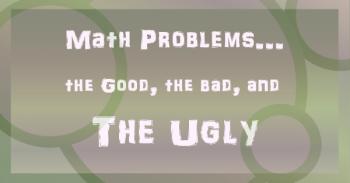
[Note: if you came to this post by way of DailyMail.co.uk, you should note that this article is based on a slightly different problem than the one they're talking about (look at the operations in the last line). Nevertheless, their proposed solution is still wrong (both for their problem and this one). Also, be sure to read our blog post about "Hard vs. Unsolvable!" Finally, if you're thinking about writing to us about this problem, please read the update at the bottom of this article.]
I should have known that after our write-up of the Apples, Bananas, and Coconuts problem went viral, we'd get asked to evaluate similar problems. Here's the latest one, and I wouldn't bother writing it up, except it has a fundamental difference from the banana problem. And people are taking the wrong lessons from the banana problem, and are still getting it wrong.

The correct answer to this question is, "No, I cannot solve this." There really is no other answer. If you came up with a numerical value, you were wrong (sorry!). Let me explain.
People who saw our write-up of the banana problem were quick to note that this problem has two similarities to that one: instead of two yellow flowers (as there are in the third line), there is only one in the last line, and instead of five petals (which it has in the second and third lines) the blue flower has only four petals in the last line.
The obvious (and erroneous) lesson to take here is that we're going to count petals instead of flowers. This leads people to the result of 25. So why is this wrong? Because the equations are not petal images; they are images of entire flowers. We can calculate the value of a red flower, we can calculate the value of a yellow flower, and we can calculate the value of a blue flower with five petals, but we do not have any information with which to calculate the value of a blue flower with four petals. Unless we make the assumption* that the entire value of a flower lies in its petals. Ask a florist if he would sell a flower for the same price if the leaves and stem had been removed. I think you know what he'll say.
Or we could make the assumption* that a flower is valued at the sum of its petals, stem, and leaves and also assume* that all petals, stems and leaves have the same value from flower to flower. In which case we could set up a system of three equations in 3 unknowns, with P representing the value of a petal, S representing the value of a stem, and L representing the value of a leaf:
36P + 3S + 3L = 60
22P + 3S + 3L = 30
21P - 1S - 3L = 3
And we need to find the value of 24P + 3S + 4L
If we subtract the second equation from the first, we get 14P = 30, or P = 15/7 (yuck).
You know what? I'm not going to follow through with this any further, because it's not a pretty system of equations, plus it's not inherently obvious that we should interpret the problem this way. So I think it's just a waste of my time.
* You will note that methods of attempting this problem will require us to make assumptions about the value of a stem, and the value of a leaf. And, furthermore, it requires us to make the assumption that each flower is worth the sum of its parts. Thus, the problem is unsolvable.
So I'm going to stick with my original answer: unlike the banana problem, this one is unsolvable.
So what is the big difference between the two problems? The difference is that in the bananas problem, each image was a representation of a number of fruits, so removing a fruit simply converts the image to another known quantity without fundamentally changing the nature of the objects represented, while in this problem the images are representations of entire flowers, so removing a petal doesn't convert it into a new known quantity; it fundamentally changes the nature of the object into something we don't know the value of.
That probably wasn't the answer the problem creator was looking for, but I don't really care - that's my answer, and I'm gonna stick to it!
Read more: Hard vs. Unsolvable!
Update June 17, 2016
This morning I received the following interesting email from Allan in Newcastle, Australia:
POLLEN PANDEMONIUM Why has nobody seen that the two yellow flowers are a multiplication (there is no + sign as there is in line 1), so that means one yellow flower is worth 1.4142.... (the sq.root of 2). The answer must therefore include .4142. I know you reject the following but . . .as the number of petals only matters for a blue flower, the answer is 25.4142.
Hi Allan! This is a fun way of looking at the problem. I don't think it's a correct way of looking at it, but it's still fun. I'll explain first why I don't think it's the correct way to look at it, but then, if you don't mind, I'll play a little game of "What if this WAS the correct way to look at it?"
Representing mathematical problems in a pictorial format is not a completely out-of-the-blue idea that the person who created this problem came up with. Math text books (especially at the younger grade levels) often use a pictorial format to illustrate math concepts. For example, in a lesson on place value, the number 27 might be represented by a picture of two rods (each representing 10), plus 7 squares (each representing one). In this case, the two rods represent exactly what they look like: two tens, not ten squared.
Similarly, if a textbook showed a picture of five dimes, a plus sign, and three more dimes, you should interpret that as a total of 8 dimes, not as 105 + 103.
So, even though I've never seen a rigorous definition of how we do pictorial mathematics, there's at least a "standard," and that standard suggests that a picture of two flowers really does represent two flowers, and not "flower squared."
Having said that, I've left a little loophole here; since I've never seen a rigorous definition, can we have some fun and see what happens if we choose to define it the way you did?
You said, in your e-mail, "the number of petals only matters for a blue flower," which is not strictly true. You see, one of the really important things we have to agree on in mathematics is that we be consistent in meaning, throughout a problem. Thus, if we need to deal at the "petal" level for blue flowers, in order to be consistent in notation, we need to deal at the "petal" level for all the flowers.
So the first equation is not 3r = 60, where r represents the value of a red flower. It's 3(12p) = 60, where p represents the value of a single red petal.
Except...if we agree to use your idea of using multiplication when no operation is presented, we now have to apply that at the petal level across the entire puzzle.
So it's not 3(12p) = 60; it's 3p12 = 60, because we have to multiply together all those petals!
So if 3p12 = 60,
p12 = 20
Which means p is actually the twelfth root of 20, which is about 1.284!
And then, of course, you need to follow the logic through on the other equations as well. :) I'm not going to do that; I'll leave it for readers to play around with the problem and see what answer they get. Thanks for your e-mail, Allan; this was a fun way to look at the problem.
When this post went viral, we started getting a large number of e-mails from helpful people who wanted to make sure we knew how to do the problem. This was exceedingly bizarre, since the article is pretty clear that it's not that we don't know how to solve the problem, but rather that there is not enough information to solve the problem without making unwarranted assumptions and therefore it cannot be solved. With the exception of the message from Allan in Newcastle (see June 17 update), each of these e-mails has done nothing but make one of the assumptions which was already addressed in this post. It makes it very evident that people are responding to this article without reading it. For this reason, we're no longer replying to emails about this post; Professor Puzzler is getting tired of simply redirecting people back to the article they should have read in the first place! Click here to read more about ambiguous math problems.

